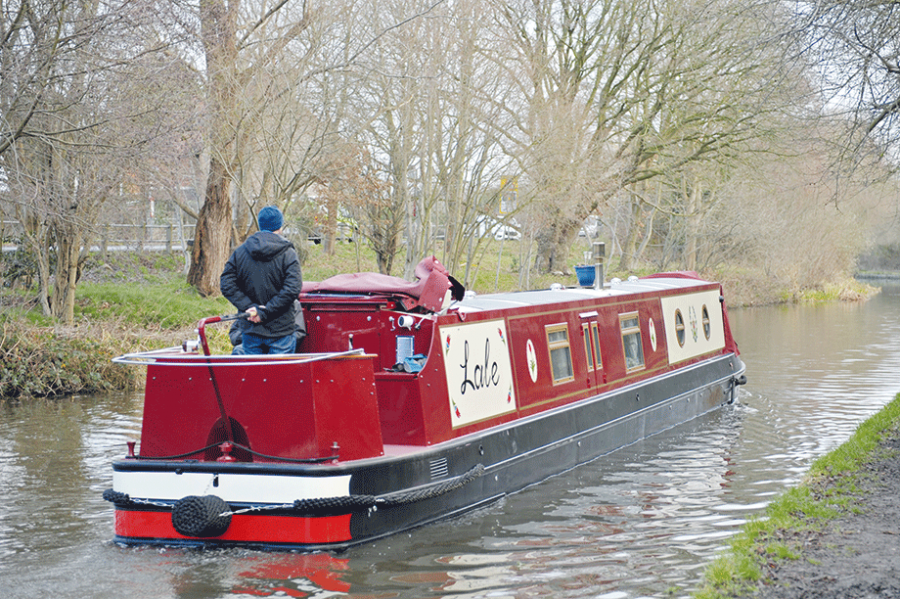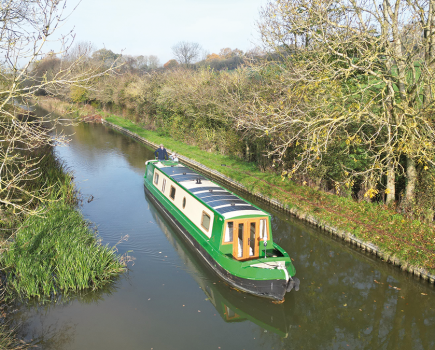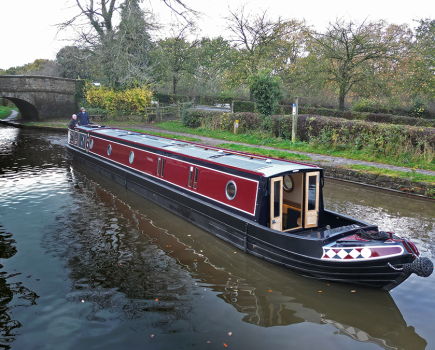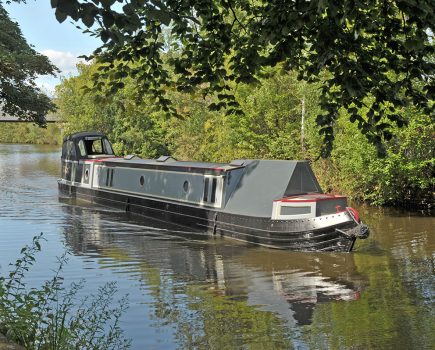It’s interesting to find out why boaters are swapping their existing boat for a new one. Sometimes they want a bit more space (and occasionally they want a bit less). Sometimes they’ve realised that a different layout would suit them better. And sometimes they want to upgrade to the latest technology. For one such couple, all these reasons are true.
Words by Adam Porters | Pictures by Andy Annable
Having spent a career travelling the world, JoDee and Paul Walters, bought a boat in retirement and have spent the past three years living aboard and continuously cruising. But such is the appeal of the canals that they’ve decided they need more time – and a new boat on which to continue their exploration.
And their new boat, Lale (which is pronounced lar-lay, as it’s the Turkish word for tulip) is very different from the previous one. They’ve swapped a relatively short boat for a longer one, have changed a standard layout for reverse (with a few tweaks that make the boat a bit different), and have made the switch from diesel propulsion to electric.
The boat has been fitted out by Tristar Boats, one of a handful of builders who’ve made the decision that all their boats will have some form of electric propulsion, either a parallel or serial hybrid system. Electric drive is clearly the way things are going, and this boat is a good example of a serial hybrid set up.
EXTERIOR
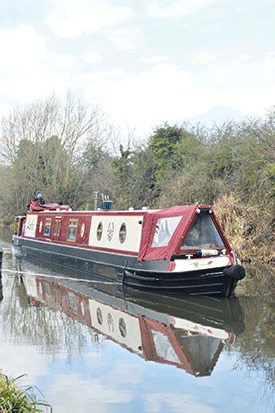 Lale is built on a 57ft shell by XR&D, a small but well respected company who specialise in narrowboats and widebeams. The styling is quite simple, so for example there are just sloping ends to the handrails rather than complicated scrolls. But the steelwork looks good: the cabin sides are nice and straight and the corners are crisp. The bow is a pleasing shape, with a substantial stem post. There’s a storage locker in the nose, and the waste tank is under the well deck; the water tank is under the bed in the cabin.
Lale is built on a 57ft shell by XR&D, a small but well respected company who specialise in narrowboats and widebeams. The styling is quite simple, so for example there are just sloping ends to the handrails rather than complicated scrolls. But the steelwork looks good: the cabin sides are nice and straight and the corners are crisp. The bow is a pleasing shape, with a substantial stem post. There’s a storage locker in the nose, and the waste tank is under the well deck; the water tank is under the bed in the cabin.
The stern has a large cruiser deck, with square corners. This means space is maximised, but the corners will inevitably take some knocks; sensibly the owners have put some rope fenders round for some protection. They’ve been made by AJ Fenders.
The deck is protected by a metal dodger, which is topped with hardwood, and there’s a large pram cover. These covers do nothing for the lines of a boat, but they are a practical addition particularly for liveaboards, turning the back deck into an extra room. The whole thing has to be dismantled for cruising, but in can be done in just a few minutes once you’ve got the hang of it, and putting it back up is also relatively straightforward. For the summer, there are flyscreens to replace the windows.
There are a couple of lockers each side of the deck, one of which is the gas locker while the other is home to a spare bottle. They also provide somewhere for crew to sit while underway. The colour scheme uses red with pale cream panels. The signwriting is by Jan Deuchar. The name is in a very non-traditional font, but the real highlights are the tulips which appear in different forms along the boat, including some in a very Turkish style.
All the trim is in chrome which is far easier to keep clean than brass, and all the windows and portholes, which are from Wesley Windows, are double glazed and have a thermal break to help prevent condensation.
LAYOUT AND FITOUT
This is a reverse layout boat, with a couple of twists which make it quite unusual. At the stern, there’s a utility room which is like a modern take on a boatman’s cabin before you get to the galley which leads into the saloon. A door takes you into the walk-through shower room, passing a laundry area on the way. The cabin, at the bow, features a bed which takes up the whole width of the boat.
The fitout uses ash on the cabin sides teamed with sapele for the trim and the hull sides. Ash is very pale while sapele is a dark reddish brown, so there’s a lot of contrast between the two. The quality of the fitout is good. Everything fits together very well, and the owners are delighted with the finish of the whole boat.
UTILITY
We’ll start at the stern, where three steps lead down into the boat from the back deck. The top and bottom steps have lifting treads for storage; the middle one doesn’t because the boat’s batteries are located underneath. Alongside the steps is the electrical cupboard on one side and a wardrobe on the other. These both have their doors on push catches. The plus side is that there are no handles or knobs to catch yourself or your clothes on as you enter the boat, but the down side is that even slightly leaning on the doors means they pop open.
On one side of the utility there’s a worktop with cupboards and drawers beneath. The calorifier is under here, and one of the cupboard doors hides a large freezer. On the opposite side, there’s open storage at the bottom, providing somewhere for boots and shoes as well as
a folding bike. There are large cupboards above which have doors which drop down to rest in a groove in the edge of the worktop. The cupboard contains a mattress, so you can make up a bed across the boat. It’s an idea which has been borrowed from the bed-holes in the back cabins of old working boats, and is a novel way of fitting in a space for guests.
GALLEY
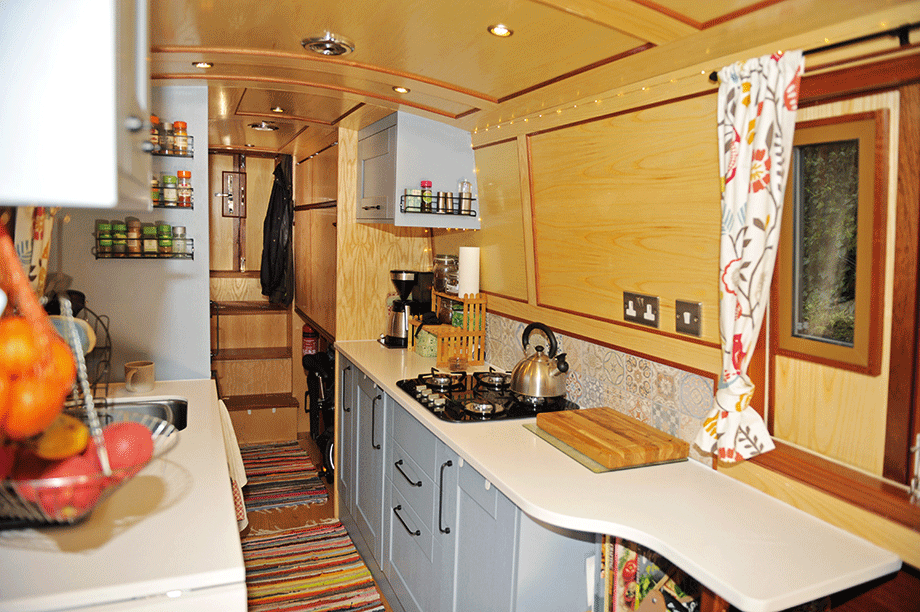 The galley is a bright and colourful space, with pale blue cupboard doors, white Durasein worktops, and pattered tiles as splashbacks. There’s plenty of storage with a range of cupboards and drawers, plus a couple of high level units. For additional worktop space, there’s a fold-up extension section at the end of one run; opposite the worktop curves to a narrower section, with shelves below.
The galley is a bright and colourful space, with pale blue cupboard doors, white Durasein worktops, and pattered tiles as splashbacks. There’s plenty of storage with a range of cupboards and drawers, plus a couple of high level units. For additional worktop space, there’s a fold-up extension section at the end of one run; opposite the worktop curves to a narrower section, with shelves below.
Equipment includes a Neff electric oven with a hide and slide door, making access much easier in the confined space. JoDee and Paul have enough battery capacity that they could have gone all-electric for cooking, but opted to stick with a Thetford gas hob – the thinking being that it’s always good to have options. If the electrical system were to fail, they’d still have a means of cooking. The fridge is a full size 240-volt model.
SALOON
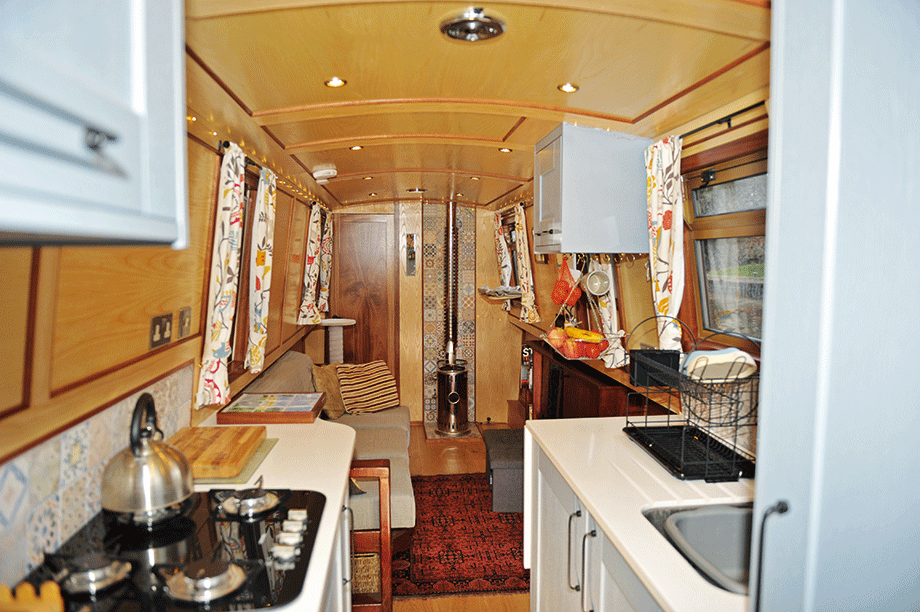 The owners were having trouble finding a sofa which fitted the space available and didn’t cost the earth – so Paul’s brother built them one. He constructed the frame to fit, and they had cushions made and upholstered.
The owners were having trouble finding a sofa which fitted the space available and didn’t cost the earth – so Paul’s brother built them one. He constructed the frame to fit, and they had cushions made and upholstered.
On the opposite side of the boat is an under-gunwale tv unit which incorporates a can cupboard behind a sliding door. Heating comes from a Lockgate Refleks diesel stove, which has a hearth of the same pattered tiles seen in the galley. JoDee and Paul chose this stove rather that a solid fuel one, so they no longer had to deal with coal and logs. They’re very pleased with it, having had it ticking over twenty-four hours a day during the cold weather; it also feeds a couple of radiators further forward in the boat.
SHOWER ROOM
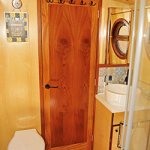 A door leads into the shower room – which is a bigger space than you expect. That’s because of a laundry area immediately behind the door. It contains a slimline Hotpoint top loading washing machine, which takes up less space than a frontloading one, but still takes 7kg of washing. This area also has a large high level cupboard, and there’s plenty of other storage space too.
A door leads into the shower room – which is a bigger space than you expect. That’s because of a laundry area immediately behind the door. It contains a slimline Hotpoint top loading washing machine, which takes up less space than a frontloading one, but still takes 7kg of washing. This area also has a large high level cupboard, and there’s plenty of other storage space too.
The shower room proper has a large quadrant shower which is lined with laminate. There’s a unit in one corner with a smart round basin on top, and a mirrored cabinet above. The loo is a macerating one by Matromarine. The owners have switched to a Jabsco controller, which they say uses less water and therefore fills up the tank less quickly.
CABIN
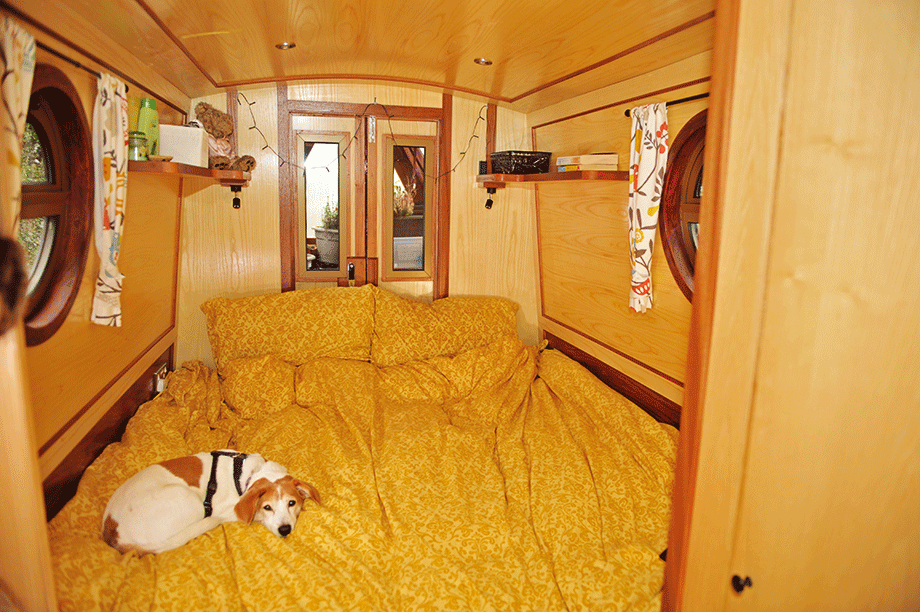 The cabin is at the bow and features a huge bed which takes up the whole of the front of the boat. This arrangement is normally seen in boats which have an extended cabin, with perhaps just a window or hatch in the forward bulkhead. It’s less common in a boat like this which has a well deck and doors at the head of the bed.
The cabin is at the bow and features a huge bed which takes up the whole of the front of the boat. This arrangement is normally seen in boats which have an extended cabin, with perhaps just a window or hatch in the forward bulkhead. It’s less common in a boat like this which has a well deck and doors at the head of the bed.
The bed base has a huge drawer giving plenty of storage, and there’s also a large wardrobe on one side of the room. Opposite there are some open shelves.
TECHNICAL
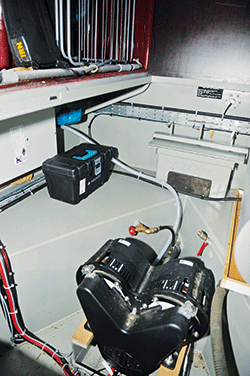 Lale is powered by a serial hybrid electric drive system. That means the prop is turned by an electric motor, and there’s a separate diesel generator to charge the batteries. That’s in contrast to a parallel hybrid system in which the prop can be turned by both a diesel engine and an electric motor.
Lale is powered by a serial hybrid electric drive system. That means the prop is turned by an electric motor, and there’s a separate diesel generator to charge the batteries. That’s in contrast to a parallel hybrid system in which the prop can be turned by both a diesel engine and an electric motor.
In this case, the electric motor is a twin drive 16kw Swordfish unit from Lynch. You can see from the shape of it that it consists of two motors, and the manufacturers say it’s lightweight at just 27kg, efficient, and reliable because it has limited moving parts. It provides plenty of power for a boat of this size – most electric drive boats we’ve tested over the past few years have had a 10kw motor.
The generator is a Beta 10, which is located in the engine hole and is cocooned in a housing to reduce noise. The advantage of having a generator rather than an engine is that it can be smaller, and as it’s specifically designed to charge batteries it’s more efficient. The batteries are also charged by the large array of solar panels on the roof. There are 12 semi-flexible 160 watt panels, amounting to almost 2kw.
The battery set up is interesting as it uses both lithium iron and lead acid batteries. The main bank is six 48 volt 100Ah LiFePo4 batteries. 600Ah at 48 volts is a huge amount of power: the equivalent at 12 volts would be 2400Ah – although that is actually an underestimate, because lithiums can be discharged down to almost nothing, while lead acids shouldn’t be allowed to go below fifty per cent. The lithiums supply power to the motor, but also charge three 100Ah 12-volt lead acid batteries – one for the domestic systems such as lighting and pumps, one for the generator start, and one for the bow thruster. There’s a Victron 5kw inverter charger to provide a 240-volt supply, and a Victron monitoring system. Although the in-boat display is fairly basic, there’s an app which allows you to see what’s going on via a tablet or phone. There’s a mass of information available, including real time readings of what the solar panels are producing, what power is being used, and what the state of charge of the batteries is. The builders, Tristar, can also log in, and say they’re found it useful to be able to provide aftersales advice to previous customers.
Lithium batteries are an expensive option, but they charge very quickly and have a very long life. Paul says that even this winter, with the solar panels providing relatively little charge, he’s had to run the generator only for a couple of hours every three days or so. In the summer with plenty of sunshine, he’s expecting to hardly have to run it at all – in fact it’s quite possible that the couple could be cruising and generating excess power at the same time, the ultimate in green boating.
ON THE WATER
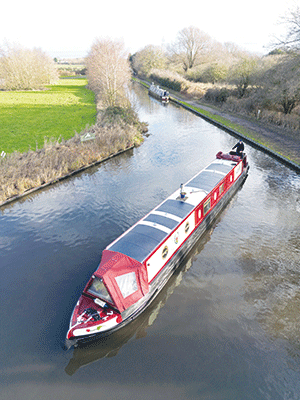 Electric propulsion is like stealth boating. There’s minimal sound from the motor, so you can hear water rippling down the side of the boat and round the prop, and you can hear what people are saying to you from the towpath. Moored boats can’t hear you coming, and seem to hardly notice when you pass.
Electric propulsion is like stealth boating. There’s minimal sound from the motor, so you can hear water rippling down the side of the boat and round the prop, and you can hear what people are saying to you from the towpath. Moored boats can’t hear you coming, and seem to hardly notice when you pass.
The handling is absolutely fine. The boat sits in the water nicely and goes exactly where it’s pointed. The tiller is light while still feeling positive. We turned a couple of times in the course of our test, and the boat went round very well. If you need the bow thruster, it has plenty of grunt.
We often complain that the Morse control is set very low down on cruiser stern boats, simply because of the design of the stern rail. On this boat, a very smart stainless steel control has been mounted on top of the rail, so it’s easily within reach. Of course with every advantage there’s a disadvantage, and in this case it’s that the control would be quite easy to knock.
CONCLUSION
This is a very individual boat which has been well executed by Tristar. In fact, the owners say they couldn’t have been happier with how the firm accommodated all their requirements, and managed to fit them into the space available. The layout won’t be universally liked, but that’s the whole point of having a bespoke boat: you commission what works for you. But there’s no doubt that quality of workmanship is excellent, and Tristar make a point of building different boats with different interior styles, depending on what the customer wants.
Technically, this boat has a state of the art set up. The electric motor is powerful yet quiet, the generator is efficient, and the battery set up gives the best of lithium and lead acid.
Price these days is a difficult subject. The owners say the boat cost them around £180,000. That sounds like a lot, but they have got a lot for their money. But as we know, prices are rocketing and supply problems are making life difficult for many boat builders. Tristar say their build slots are fully booked until 2024, and while they’re happy to meet potential customers they can’t price up boats that far into the future. It sounds like a wise decision, because no-one can predict the price of anything two years from now.
If you’re going to replace your existing boat with a brand new one, you might as well go the whole hog and get exactly what you want, with the latest tech. And that’s exactly what JoDee and Paul have got.
The Owners
 JoDee and Paul Walters have lived all over the world in their careers as teachers, and then in teacher training. They spent time in Turkey, Saudi Arabia, the Seychelles, Japan, and Egypt. They also lived here in the UK, and it was in 2006 that they took a narrowboat holiday and decided that one day they’d get a boat and explore the system.
JoDee and Paul Walters have lived all over the world in their careers as teachers, and then in teacher training. They spent time in Turkey, Saudi Arabia, the Seychelles, Japan, and Egypt. They also lived here in the UK, and it was in 2006 that they took a narrowboat holiday and decided that one day they’d get a boat and explore the system.
The couple retired in 2017, and went to JoDee’s native US, where they lived in an RV with her mother and travelled widely. Route 66 was a highlight. In 2019, they bought a second hand boat and began the liveaboard life. It was a 52ft trad, built in 2007, with a standard layout.
The plan was to spend a couple of years on the water, but when the time came they decided they were enjoying themselves too much and hadn’t been to nearly enough places. So a new boat to better suit their needs was on the cards. They were fortunate that Tristar Boats had a built slot available at the right time for them, thanks to a cancellation. They share the boat with their dog, Penny, and two cats, Missy and Millie.
Specification
Length: 57ft
Beam: 6ft 10in
Shell: XR&D 01623 863576
Style: Cruiser
Layout: Reverse
Berths: 2+2
Fit-out: Ash and sapele
Electric motor: Lynch Swordfish 16k www.lynchmotors.co.uk
Generator: BetaGen 10 www.betamarine.co.uk
Bow thruster: Quick 185 5kw www.quickitaly.com
Inverter: Victron 48 5kw www.victronenergy.com
Washing machine: Hotpoint Aquarius 7kg www.hotpoint.co.uk £399
Worktops: Duraseinfrom £365 per 3m www.durasein.co.uk
CONTACT:
Redhill Marina
Ratcliffe-on-Soar, Nottinghamshire, NG11 0EB
07759 246551 / 07976 097042
www.tristarboats.com
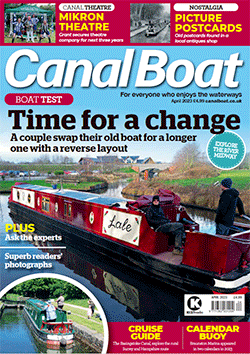 As featured in the April 2023 issue of Canal Boat. Buy the issue here
As featured in the April 2023 issue of Canal Boat. Buy the issue here

